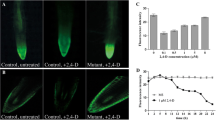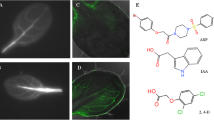Abstract
The diageotropica (dgt) mutation has been proposed to affect either auxin perception or responsiveness in tomato plants. It has previously been demonstrated that the expression of one member of the Aux/IAA family of auxin-regulated genes is reduced in dgt plants. Here, we report the cloning of ten new members of the tomato Aux/IAA family by PCR amplification based on conserved protein domains. All of the gene family members except one (LeIAA7) are expressed in etiolated tomato seedlings, although they demonstrate tissue specificity (e.g. increased expression in hypocotyls vs. roots) within the seedling. The wild-type auxin-response characteristics of the expression of these tomato LeIAA genes are similar to those previously described for Aux/IAA family members in Arabidopsis. In dgt seedlings, auxin stimulation of gene expression was reduced in only a subset of LeIAA genes (LeIAA5, 8, 10, and 11), with the greatest reduction associated with those genes with the strongest wild-type response to auxin. The remaining LeIAA genes tested exhibited essentially the same induction levels in response to the hormone in both dgt and wild-type hypocotyls. These results confirm that dgt plants can perceive auxin and suggest that a specific step in early auxin signal transduction is disrupted by the dgt mutation.
Similar content being viewed by others
References
Abel, S. and Theologis, A. 1995. A polymorphic bipartite motif signals nuclear targeting of early auxin-inducible proteins related to PS-IAA4 from pea (Pisum sativum). Plant J. 8: 87–96.
Abel, S. and Theologis, A. 1996. Early genes and auxin action. Plant Physiol. 111: 9–17.
Abel, S., Oeller, P.W. and Theologis, A. 1994. Early auxin-induced genes encode short-lived nuclear proteins. Proc. Natl. Acad. Sci. USA 91: 326–330.
Abel, S., Nguyen, M.D. and Theologis, A. 1995. The PS-IAA4/5-like family of early auxin-inducible mRNAs in Arabidopsis thaliana. J. Mol. Biol. 251: 533–549.
Ainley, W.M., Walker, J.C., Nagao, R.T. and Key, J.L. 1988. Sequence and characterization of two auxin-regulated genes from soybean. J. Biol. Chem. 263: 10658–10666.
Ballas, N., Wong, L.-M., Ke, M. and Theologis, A. 1995. Two auxin-responsive domains interact positively to induce expression of the early indoleacetic acid-inducible gene PS-IAA4/5. Proc. Natl. Acad. Sci. USA 92: 3483–3487.
Bowler, C., Neuhaus, G., Yamagata, H. and Chua, N.-H. 1994. Cyclic GMP and calcium mediate phytochrome phototransduction. Cell 77: 73–81.
Chomczynski, P. and Sacchi, N. 1987. Single-step method of RNA isolation by acid guanidinium thiocyanate-phenol-chloroform extraction. Anal. Biochem. 162: 156–159.
Cleland, R.E. 1995. Auxin and cell elongation. In: P.J. Davies (Ed.) Plant Hormones: Physiology, Biochemistry and Molecular Biology, Kluwer Academic Publishers, Dordrecht, Netherlands, pp. 214–228.
Conner, T.W., Goekjian, V.H., LaFayette, P.R. and Key, J.L. 1990. Structure and expression of two auxin-inducible genes from Arabidopsis. Plant Mol. Biol. 15: 623–632.
Daniel, S.G., Rayle, D.L. and Cleland, R.E. 1989. Auxin physiology of the tomato mutant diageotropica. Plant Physiol. 91: 804–807.
Felsenstein, J. 1989. PHYLIP: phylogeny inference package version 3.2. Cladistics 5: 164–166.
Fleming, A.J., Mandel, T., Roth, I. and Kuhlemeier, C. 1993. The patterns of gene expression in the tomato shoot apical meristem. Plant Cell 5: 297–309.
Fujino, D.W., Nissen, S.J., Jones, A.D., Burger, D.W. and Bradford, K.J. 1988. Quantification of indole-3-acetic acid in dark-grown seedlings of the diageotropica and epinastic mutants of tomato (Lycopersicon esculentum Mill.). Plant Physiol. 88: 780–784.
Hashimoto, H. and Yamamoto, K.T. 1997. Three more members of the Aux/IAA gene family from mung bean (Vigna radiata) hypocotyl. Plant Physiol. 115: 315.
Jackson, M.B. 1979. Is the diageotropic tomato ethylene deficient? Physiol. Plant 46: 347–351.
Kelly, M.O. and Bradford, K.J. 1986. Insensitivity of the diageotropica tomato mutant to auxin. Plant Physiol. 82: 713–717.
Kim, J., Harter, K. and Theologis, A. 1997. Protein-protein interactions among the Aux/IAA proteins. Proc. Natl. Acad. Sci. USA 94: 11786–11791.
Lomax, T.L., Coenen, C., Gaiser, J.C., Hopkins, R., Rayle, D.L. and Rice, M.S. 1993. Auxin perception and the regulation of tomato growth and development. In: J.I. Yoder (Ed.) Molecular Biology of Tomato, Technomic Publishing Co., Lancaster, UK, pp. 129–138.
Mito, N. and Bennett, A.B. 1995. The diageotropica mutation and synthetic auxins differentially affect the expression of auxinregulated genes in tomato. Plant Physiol. 109: 293–297.
Muday, G.K., Lomax, T.L. and Rayle, D.L. 1995. Characterization of the growth and auxin physiology of roots of the tomato mutant diageotropica. Planta 195: 548–553.
Nebenführ, A. and Lomax, T.L. 1998. Multiplex titration RT-PCR: a method for rapid determination of gene expression patterns for a large number of genes. Plant Mol. Biol. Rep. 16: 323–339.
Neuhaus, G., Bowler, C., Kern, R. and Chua, N.-H. 1993. Calcium/calmodulin-dependent and-independent phytochrome signal transduction pathways. Cell 73: 937–952.
Oeller, P.W., Keller, J.A., Parks, J.E., Silbert, J.E. and Theologis, A. 1993. Structural characterization of the early indoleacetic acidinducible genes, PS-IAA4/5 and PS-IAA6, of pea (Pisum sativum L.). J. Mol. Biol. 233: 789–798.
Oono, Y., Chen, Q.G., Overvoorde, P.J., Köhler, C. and Theologis, A. 1998. age mutants of Arabidopsis exhibit altered auxin-regulated gene expression. Plant Cell 10: 1649–1662.
Rice, M.S. and Lomax, T.L. 2000. The auxin-resistant diageotropica mutant of tomato responds to gravity via an auxin-mediated pathway. Planta, in press.
Rogers, S.O. and Bendich, A.J. 1994. Extraction of total cellular DNA from plants, algae and fungi. In: S.B. Gelvin and R.A. Schilperpoort (Eds.) Plant Molecular Biology Manual, Kluwer Academic Publishers, Dordrecht, Netherlands, pp. D1: 1–8.
Rouse, D., Mackay, P., Stirnberg, P. and Leyser, O. 1998. Changes in auxin reponse from mutations in an AUX/IAA gene. Science 279: 1371–1373.
Saitou, N. and Nei, M. 1987. The neighbor-joining method: a new method for reconstructing phylogenetic trees. Mol. Biol. Evol. 4: 406–425.
Theologis, A., Huynh, T.V. and Davis, R.W. 1985. Rapid induction of specific mRNAs by auxin in pea epicotyl tissue. J. Mol. Biol. 183: 53–68.
Thompson, J.D., Higgins, D.G. and Gibson, T.J. 1994. ClustalW: improving the sensitivity of progressive multiple sequence alignments through sequence weighting, position specific gap penalties and weight matrix choice. Nucl. Acids Res. 22: 4679–4680.
Tian, Q. and Reed, J. 1999. Control of auxin-regulated root development by the Arabidopsis thaliana SHY2/IAA3 gene. Development 126: 711–721.
Ulmasov, T., Hagen, G. and Guilfoyle, T.J. 1997a. ARF1, a transcription factor that binds to auxin response elements. Science 276: 1865–1868.
Ulmasov, T., Murfett, J., Hagen, G. and Guilfoyle, T.J. 1997b. Aux/IAA proteins repress expression of reporter genes containing natural and highly active synthetic auxin response elements. Plant Cell 9: 1963–1971.
Ulmasov, T., Hagen, G. and Guilfoyle, T.J. 1999. Dimerization and DNA binding of auxin response factors. Plant J. 19: 309–319.
Yamamoto, K.T., Mori, H. and Imaseki, H. 1992. cDNA cloning of indole-3-acetic acid-regulated genes: Aux22 and SAUR from mung bean (Vigna radiata) hypocotyl tissue. Plant Cell Physiol. 33: 93–97.
Zobel, R.W. 1974. Control of morphogenesis in the ethylenerequiring tomato mutant, diageotropica. Can. J. Bot. 52: 735–743.
Zurek, D.M., Rayle, D.L., McMorris, T.C. and Clouse, S.D. 1994. Investigation of gene expression, growth kinetics, and wall extensibility during brassinosteroid-regulated stem elongation. Plant Physiol. 104: 505–513.
Author information
Authors and Affiliations
Rights and permissions
About this article
Cite this article
Nebenführ, A., White, T. & Lomax, T.L. The diageotropica mutation alters auxin induction of a subset of the Aux/IAA gene family in tomato. Plant Mol Biol 44, 73–84 (2000). https://doi.org/10.1023/A:1006437205596
Issue Date:
DOI: https://doi.org/10.1023/A:1006437205596




